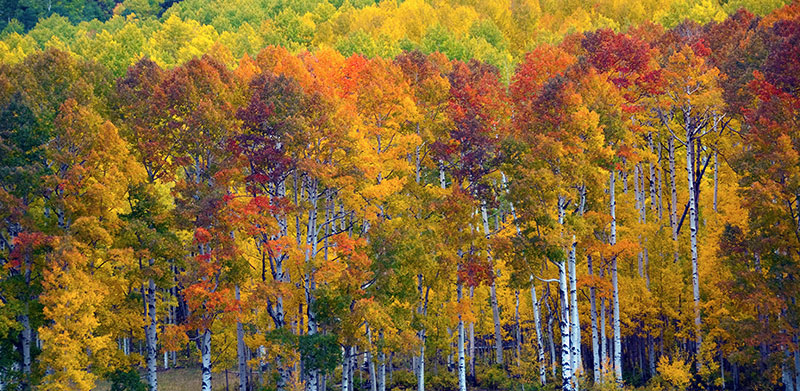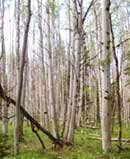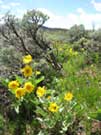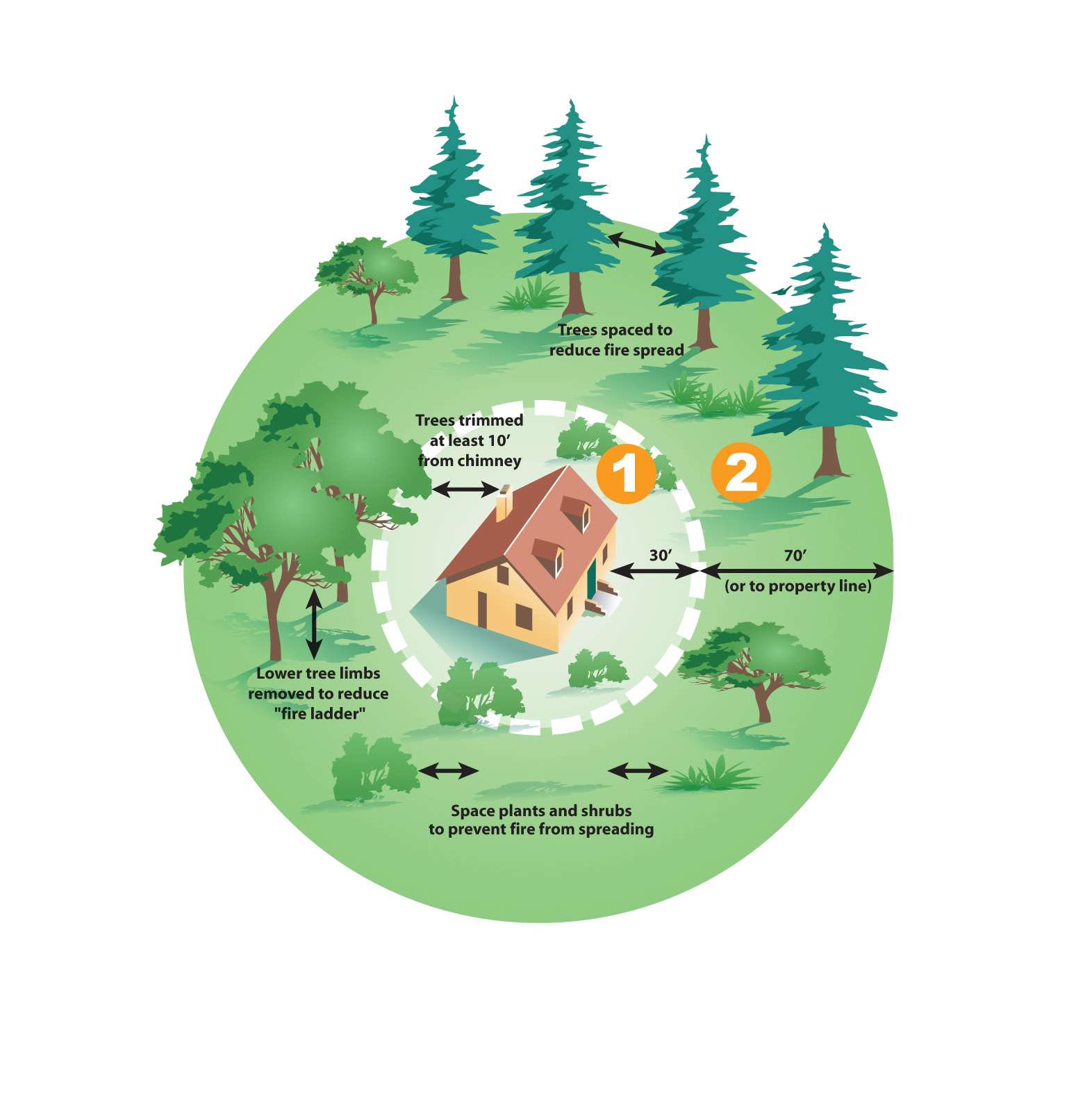Forests
Colorado has roughly 22 million acres of forest, of which nearly 7 million are privately owned. We recommend that forest landowners take on the responsibility of managing their forests to reduce the potential for damages caused by wildfire, insect outbreaks, and disease infestations.

Steps to manage your forest property:
- Understand your resource,
- Develop your objectives,
- Schedule your activities,
- Implement your plan.
A Forest Stewardship Plan is a cost-effective way to document your forest property management plan and understand your management approach. Start by:
- Hire a consulting forester to inventory your timber and write a management plan, (OR)
- Conduct a basic self assessment of your forest and design a management plan with assistance from:
Small Acreage Forest Condition Assessment
Conduct a basic assessment for your forest land
Need Help Identifying your trees?
These resources can help!
Learn more about the forest management process
Reasons to Manage the Density of Your Forested Land
 Improve Forest Health – Well managed forests are more resistant to diseases and insect damage such as mountain pine beetle, Armillaria Root Disease, or dwarf mistletoe which are just a few of the major forest health concerns that landowners face in CO. Reduce stress in forest stands to promote natural resistance and diminish susceptibility to damage.
Improve Forest Health – Well managed forests are more resistant to diseases and insect damage such as mountain pine beetle, Armillaria Root Disease, or dwarf mistletoe which are just a few of the major forest health concerns that landowners face in CO. Reduce stress in forest stands to promote natural resistance and diminish susceptibility to damage.
- Reduce Wildfire Hazard – Thin overstocked or high density forests to allow
 a potential high severity crown fire to drop to the ground as a low severity fire that can be suppressed more readily with less damaging effects to soil, water, and plant resources. Create strategic “fuel breaks” or “defensible space” to protect your home and property.
a potential high severity crown fire to drop to the ground as a low severity fire that can be suppressed more readily with less damaging effects to soil, water, and plant resources. Create strategic “fuel breaks” or “defensible space” to protect your home and property.

- Increase Wildlife Habitat – We can manage forests for fish and wildlife; thin overstocked or high density forests. This will allow sunlight and precipitation to reach the ground and encourage herbaceous cover, such as grasses, wildflowers, and shrubs, for birds and other wildlife to consume. Additionally, create habitat for wildlife and forage that will make your garden safe from wildlife damage.
- Protect Water and Soil – healthy forests keep soils from eroding, and
 protect our water quality. The loss of vegetation caused by a wildfire will cause soils to erode and reduce the forest’s ability to retain snowpack for a more sustained runoff in the spring and summer. Eroding soils can also pollute our water supply with sediments and excess nutrients. Utilize Forestry Best Management Practices (BMPs) to significantly add to the beneficial stewardship of our forestlands and ensure adequate protection of our vital water resources.
protect our water quality. The loss of vegetation caused by a wildfire will cause soils to erode and reduce the forest’s ability to retain snowpack for a more sustained runoff in the spring and summer. Eroding soils can also pollute our water supply with sediments and excess nutrients. Utilize Forestry Best Management Practices (BMPs) to significantly add to the beneficial stewardship of our forestlands and ensure adequate protection of our vital water resources.
- Save Money – Plan for management activities, reduce the spread of noxious weeds, and decrease
 fuels available for a wildfire to consume will all help to reduce costs and inputs to your land and allow for multiple benefits. Utilize management techniques on your forest; this will far out-weigh the costs of unexpected silvicultural operations, weed suppression, fire suppression, property loss, and post-fire rehabilitation that could be caused by a wildfire. Additionally, a healthy forest is a more productive forest and can increase potential income opportunities.
fuels available for a wildfire to consume will all help to reduce costs and inputs to your land and allow for multiple benefits. Utilize management techniques on your forest; this will far out-weigh the costs of unexpected silvicultural operations, weed suppression, fire suppression, property loss, and post-fire rehabilitation that could be caused by a wildfire. Additionally, a healthy forest is a more productive forest and can increase potential income opportunities.
CPW Highlights a Forest Restoration Project:
Own just a few acres of forested land?
We can help!
A significant proportion of small acreage landowners possess just a few acres and maintain the property as a lifestyle choice. While the principles behind managing these small parcels are the same, the route with which management ensues can differ significantly. However, the resource concerns (weed invasions, poor tree health, poor wildlife habitat, etc.) and ability for the property condition to decline over time without proper management remains considerable.
FireWise
Are you FireWise?
Photo by CAL FIRE
- Defensible Space Checklist – CSFS checklist for creating D-Space
- Colorado’s Are You Firewise? Program – CSFS homeowner education
- FireWise Communities Program – Homeowner references and tools
- Forest Home Fire Safety – Mitigate wildfire hazards around your home
- CSFS Defensible Space – Understand how to create and manage D-Space
- Living with the Treat of Wildfire – City of Boulder, CO guidelines
Resources
Resources & Helpful Information
SAM Webinars and Web Videos
- Apples for Colorado below 7000′
- Best Management Practices on Forested Small Acreages
- Colorado Native Fruits
- Creating a Wildfire Defensible Space
- Firewise Landscaping Webinar Series: Defensible space is not moonscape!
- Firewise Landscaping Webinar Series: Fire-Resistant Plants
- Major Forest Health Concerns for Small Acreage Landowners
- Proper Tree Care Practices for Small Acreage Landowners
- Stone Fruits for Colorado below 7000’
- The Importance of Rootstock Selection when Growing Fruit Trees
- Wildlife Habitat Improvements for Forests in Colorado
- Windbreak Design and Maintenance in Colorado
SAM Newsletter Articles
- Beetle Outbreak Impacts – spring 2021
- Fire Resistant Landscaping – spring 2020
- Payson Lupine and Silvery Lupine – winter 2020
- Which Trees to Transplant in Spring and Fall – winter 2020
- Colorado Woody Plants App – summer 2019
- Spring Cleaning Includes Reducing Fire Hazards Around Your Home – spring 2017
- Winter Watering – winter 2017
- Landowners Can Receive Federal Assistance to Protect Forestlands – summer 2016
- Help Slow the Spread of Emerald Ash Borer – summer 2016
- How to Identify Colorado Conifers – winter 2016
- What’s Wrong With These Leaves? – summer 2015
- Landscape Health Update: Cold Snap Lingering Effects – winter 2015
- Why Use a Native Hedge? – winter 2015
- Emerald Ash Borer Detected In Colorado – winter 2014
- Resourceful Idea Helps Tree Seedlings Acclimate – winter 2012
- Winter Plant Protection – fall 2011
- Wildfire Defense for Small Acreages – spring 2011
- Stop the Japanese Beetle – fall 2010
- Choosing a Forestry Contractor – winter 2009
- Mountain Pine Beetle – winter 2009
CSU Extension Fact Sheets
- Evergreen Trees
- Small Deciduous Trees
- Large Deciduous Trees
- Trees and Shrubs for Mountain Areas
- Native Trees for Colorado Landscapes
- Xeriscaping: Trees and Shrubs
Relevant Resources
- Forest Home Fire Safety – mitigate wildfire hazards around your home
- Gambel oak Management – management for oak brush
- Insects that Feed on CO Trees and Shrubs – information on insects
- Landowner Guide to Thinning – a guide to help select the trees to cut
- Living with the Treat of Wildfire – in the Wildland-Urban interface
- Piñon-Juniper Management – a quick guide for living in piñon-juniper
More Info
- Colorado State Forest Service – provides assistance in managing land
- Colorado Tree Seedling Sale – CSFS seedling trees for conservation
- Colorado Tree Farmers – management of private forest
- CSFS Landowner Factsheets – CSFS publications including wildfires
- CSU Extension Wildfire and Forestry Factsheets – CSU publications
- NRCS Forestry – combining agriculture and forestry
Additional Resources
- Trees Are Good – tree care information and education by ISA
- Tamarisk Coalition – assistance for the restoration of riparian lands
- Society of American Foresters –scientific and educational organization
- Utah State University Extension Forestry – UT educational programs
- Barnyards and Backyards – Univ. of WY Extension Rural living info.





